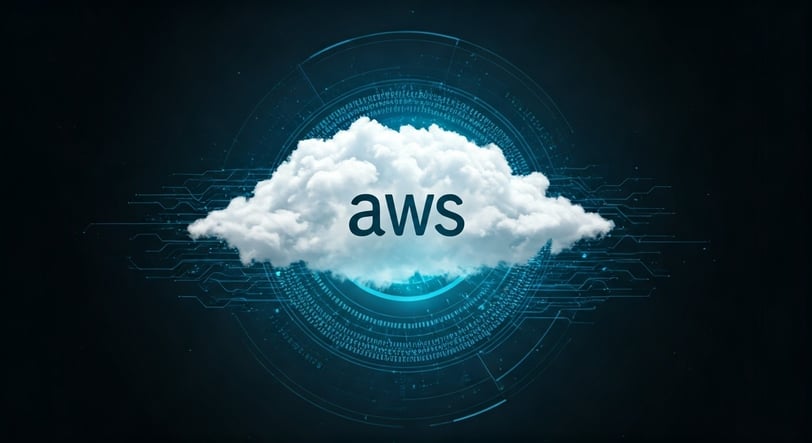
What is AWS Compute Optimizer? Full Guide to Pricing, RDS, CLI & Cost Savings
In today’s online world, cloud computing is key for scaling resources effectively while keeping performance steady. AWS Compute Optimizer is a great tool to help with this. It uses machine learning to look at usage patterns and offers tips to lower costs and improve application performance. Whether you’re working with EC2 instances, Lambda functions, or Auto Scaling, getting specific insights can save money and increase efficiency. This article shares details about AWS Compute Optimizer's pricing, its connection with RDS, how to use it with CLI, and how it helps cut costs for better outcomes.
DEVOPS
Key Highlights
Optimized Resource Utilization: AWS Compute Optimizer recommends right-sizing solutions for Amazon EC2 instances, EBS volumes, Lambda functions, and Auto Scaling Groups to maximize system efficiency and enhance resource efficiency.
Cost Management: Helps users identify over-provisioned and underutilized resources, cutting unnecessary cloud expenses significantly.
Machine Learning Integration: Uses historical usage patterns from AWS CloudWatch metrics to generate tailored optimization recommendations.
Free Tier & Enhanced Features: Core functionalities are free, but paid features like Enhanced Infrastructure Metrics offer deeper insights for advanced services such as Amazon RDS.
Integration Capabilities: Connects seamlessly with AWS CLI and other tools for automated and simplified cloud operations.
Introduction
In today’s online world, cloud computing is key for scaling resources effectively while keeping performance steady. AWS Compute Optimizer is a great tool to help with this. It uses machine learning to look at usage patterns and offers tips to lower costs and improve application performance. Whether you’re working with EC2 instances, Lambda functions, or Auto Scaling, getting specific insights can save money and increase efficiency. This article shares details about AWS Compute Optimizer's pricing, its connection with RDS, how to use it with CLI, and how it helps cut costs for better outcomes.
Exploring AWS Compute Optimizer: Comprehensive Guide to Pricing, RDS, CLI & Cost Savings
When cloud resources are not managed well, expenses can become unpredictable. The AWS Compute Optimizer helps save costs in this situation by optimizing your AWS resources. This tool looks at your AWS environment and finds ways to adjust settings for better efficiency. Its easy-to-follow advice makes sure you are not using too much or too little for your workloads.
From price levels to specific services like Amazon RDS, AWS Compute Optimizer is key for managing resources. Explore how its CLI features and customized suggestions can lead to major cost savings in your AWS setup.
1. Understanding Pricing for AWS Compute Optimizer
AWS Compute Optimizer gives you free access to its main features. You can analyze EC2 instances, EBS volumes, Lambda functions, and Auto Scaling Groups without any setup fees. This makes it easy for anyone with an AWS account to use.
However, if you want advanced recommendations for services like Amazon RDS (Relational Database Service), you need to pay for Enhanced Infrastructure Metrics. Turning this feature on allows Compute Optimizer to capture more detailed metrics, such as CPU usage, memory use, and disk throughput for three months instead of the usual 14 days. While this does add some charges through CloudWatch, many users find that the better accuracy leads to overall cost savings.
For companies wanting more than basic insights, this mix of free and paid options offers flexibility. You only have extra costs when you want in-depth metrics for important, resource-heavy services like performance cookies. This pricing system helps with effective cost management across different workloads.
2. Leveraging RDS with AWS Compute Optimizer
Amazon RDS works well with AWS Compute Optimizer. It helps you understand how your database performs while keeping it set up correctly. Unlike the analysis for EC2 and Lambda available for free, RDS needs you to turn on paid features like Enhanced Infrastructure Metrics.
This tool gives you detailed information such as CPU usage, storage IOPS, and workload patterns. It offers useful suggestions for better database performance. For instance, it can point out memory that is not being used enough or recommend resizing database instances to save money.
Even though RDS support costs extra, using these metrics is worth it for apps that depend on high-performance databases. With these personalized suggestions, businesses can save money while keeping resources available and fast. For those dealing with costly and complex RDS workloads, AWS Compute Optimizer’s enhanced metrics can be a smart way to save.
3. Utilizing AWS CLI for Compute Optimizer Operations
AWS CLI integration is a game-changer for users who want to use Compute Optimizer's features. This command-line tool makes it easy for developers to get performance recommendations without needing the AWS Management Console.
With AWS CLI, administrators can automate regular audits. For example, they can gather utilization metrics and adjust resource sizes using scripts or batch commands. This saves time by removing the need to navigate manually, and it boosts productivity for large-scale infrastructures.
Besides automation, AWS CLI makes it easier to optimize resources. A developer can programmatically check database recommendations, change EC2 instance types, or keep an eye on Lambda functions, all while speeding up necessary fixes. For anyone managing large workloads or wanting smooth operations, AWS CLI makes using Compute Optimizer recommendations simple and efficient.
4. Strategies for Maximizing Cost Savings
Maximizing cost savings with AWS Savings Plans and AWS Compute Optimizer requires smart plans for using your resources. By using insights on instances, volumes, and functions, you can cut cloud costs effectively.
Prioritize Over-Provisioned Instances: Find and reduce any EC2 instances that are too big to smaller ones.
Utilize Enhanced Metrics for Storage: Pay for more detailed EBS and RDS analysis to get custom recommendations.
Automate with AWS CLI: Make optimization tasks the same without doing them by hand, which lowers mistakes and keeps things consistent.
Also, looking at past usage patterns from AWS CloudWatch helps you predict future needs and scale confidently. By adding Compute Optimizer with scripts, Terraform, or other automated tools, companies can save money for a long time while using resources better. This tool makes sure workflows run smoothly and cost-effectively at all levels.
How AWS Compute Optimizer Enhances Cloud Efficiency
AWS Compute Optimizer helps make cloud usage much better. It looks at how much resources are being used and gives helpful tips. This includes changing the size of EC2 instances or making Lambda memory better. It makes sure that resources fit the needs of the workloads.
Thanks to machine learning, it can spot when resources are not enough, which helps avoid slowdowns and delays. By managing resources better and adjusting them, users can cut down on waste and keep everything running well. It also works well with tools like AWS CLI, which helps improve operations, especially for big and changing setups.
Key Functions and Operational Overview
AWS Compute Optimizer reviews your cloud resources by using data from AWS CloudWatch. It gives suggestions for EC2 instances, EBS volumes, AWS Lambda functions settings, and Auto Scaling Groups. Its advanced machine learning methods look at past usage data like CPU, memory, and storage to find wasteful usage.
For instance, it puts resources into three groups: “over-provisioned,” “under-provisioned,” and “optimized.” This classification helps businesses see where they can make improvements. Also, better features like memory suggestions and usage charts show clear insights visually.
The recommendations from Compute Optimizer help users align resource use with their workload needs. This way, they achieve cost efficiency and run operations smoothly. By connecting these features to AWS dashboards, it makes cloud management easier across different setups.
Impact on Resource Management and Allocation
Compute Optimizer improves how we manage resources. It does this by matching setups with workload needs. This helps to keep costs low while making sure performance is top-notch. A big feature is its ability to look at usage data often. This allows for exact adjustments when needed.
This smart way of aligning resources not only saves money but also stops any unnecessary slowdowns. Overall, Compute Optimizer helps to organize allocations for smoother cloud operations.
Benefits of Integrating AWS Compute Optimizer into Your Workflow
Integrating the power of AWS Compute Optimizer into your operations brings many benefits. It can improve performance and help manage costs. It offers automated suggestions that adjust your resource setup by looking at past usage trends.
Its fit with the AWS ecosystem makes it easy to deploy with no extra agents needed. Tools like AWS CLI help make this service easy to use for better resource optimization. These features make AWS Compute Optimizer important for companies that want to boost system efficiency.
Improved Performance through Automated Recommendations
Automated recommendations from AWS Compute Optimizer can really improve application performance by enhancing CPU utilization. It looks at past utilization metrics and suggests the right configurations based on your workload needs.
For instance, changing an EC2 instance to a smaller one that fits CPU and memory needs can lower costs and stop application delays. It also optimizes EBS configurations so that the storage meets IOPS requirements well.
These insights help businesses remove inefficiencies without needing manual intervention. With machine learning, the recommendations target specific performance issues, making work processes a lot better.
Cost Reduction Techniques via Efficient Resource Utilization
AWS Compute Optimizer helps lower cloud costs by improving resource usage. It finds overused settings such as big EC2 instances and suggests changes.
For EBS volumes, Compute Optimizer helps businesses manage their storage based on important factors like read/write speed and flow. It also gives advice for Lambda to better use memory, so companies avoid extra expenses.
Overall, Compute Optimizer focuses on saving money with the right settings. When used with CLI automation or scripts, it allows users to easily make ongoing cost improvements, leading to real savings.
Potential Limitations and Considerations of AWS Compute Optimizer
AWS Compute Optimizer is great at managing resources, but it has some limits. For example, it gives recommendations for RDS based on paid upgrades. Also, it lacks broader insights for other AWS options, like DynamoDB.
Moreover, strange events or changes in workload may affect the results. Users should look closely at the personalized recommendations before use. This way, they can make sure they match their business needs and rules, while also considering any effects from third parties. Even with these issues, it is still a useful tool for cost savings in dedicated AWS settings.
Scope of Service and Recommendation Boundaries
AWS Compute Optimizer works with certain AWS services only. These include EC2, EBS, Lambda functions, and Auto Scaling Groups. However, it does not include RDS in its free tier. If you need to analyze areas not covered, like ECS or DynamoDB, you might need extra tools.
The tool focuses on collected metrics and does not consider things like SLAs. This means the recommendations could clash with your specific business needs. While it meets basic requirements, you may need additional solutions for wider use.
Analyzing the Cost-Benefit Ratio in Specific Scenarios
Cost-benefit analysis for Compute Optimizer depends on how much you use it. If you have a lot of EC2 or RDS workloads, upgrading can save you a lot of money. For smaller operations, free features are usually enough.
Organizations should find the expensive parts of their cloud platforms infrastructure. They need to see how much they can save by optimizing them. Sometimes, Compute Optimizer suggests downsizing some resources right away. This can cut costs without disrupting work. In special cases needing multi-cloud setups, using third-party options might work better.
By understanding the cost and benefit of different resources, users can manage their workloads smartly. This helps to get the most return on investment.
Conclusion
In conclusion, AWS Compute Optimizer is a strong tool that can greatly improve your cloud efficiency and enable performance optimization. It gives you custom advice on how to use resources and save costs. When you know its pricing and use RDS features, plus the AWS CLI for tasks, you can get the most out of this service. Adding AWS Compute Optimizer to your work can lead to better performance and help you manage resources smarter. This aligns with your business goals. However, it’s important to think about its limits and look at the cost compared to benefits in your situation. To see how AWS Compute Optimizer can fit your needs, contact our experts today.
Frequently Asked Questions
What specific recommendations does AWS Compute Optimizer provide?
AWS Compute Optimizer gives advice on adjusting EC2 instances, using the best Elastic Block Storage (EBS) volumes, changing Lambda functions, and setting up Auto Scaling. It studies different instance types, how they are used, and their workload performance. This helps it provide specific tips for getting the best setups possible.
How does AWS Compute Optimizer differ from AWS Cost Explorer?
AWS Compute Optimizer gives tips for improving cloud resources in the future based on best practices. On the other hand, AWS Cost Explorer looks at how you spent money in the past. Compute Optimizer focuses on making systems run better. Cost Explorer is about managing costs by analyzing previous spending.
Can AWS Compute Optimizer be used for all AWS services?
No, AWS Compute Optimizer works with specific services. These include EC2 instances, EBS volumes, Lambda functions, and Auto Scaling Groups. However, it does not support some services like DynamoDB and Amazon S3. This limits its ability for wider cloud operations and resource optimization.
What are the prerequisites for implementing AWS Compute Optimizer?
To use the AWS Compute Optimizer, you must have an active AWS account. You also need a management system within the AWS infrastructure. To analyze data, metrics from AWS CloudWatch are necessary. Enabling Enhanced Infrastructure Metrics can give you more detailed insights about resources.



